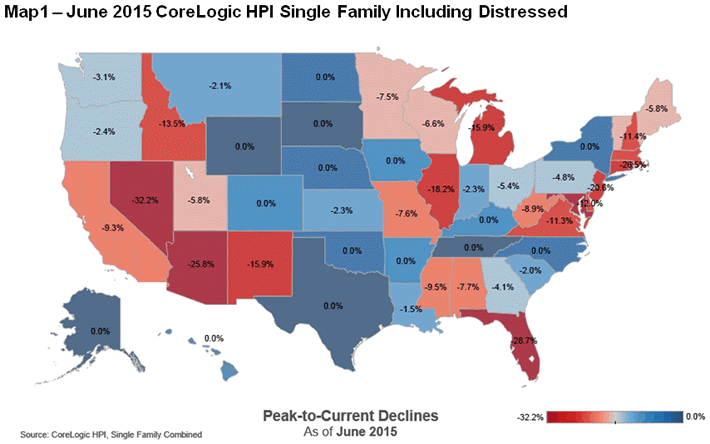The numbers of homes for sale in a few areas of the country have now dropped below a two month supply CoreLogic said today. Prices in cities with these tight inventories have appreciated faster than the rest of the country, but supplies are limited through much of the nation.
The company said that its Home Price Index (HPI) for June, shows that nationwide home prices, including distressed sales, were up 6.5 percent compared to June 2014, the 40th consecutive month of annual price gains. The index increased by 1.7 percent from May to June.
Including distressed sales the peak-to-current change in the national HPI (from April 2006 to June 2015) was -7.4 percent. Excluding distressed transactions, the peak-to-current change for the same period was -4 percent.

Thirty-five states and the District of Columbia were at or within 10 percent of their peak prices in June and 15 states and the District of Columbia established new price peaks-Alaska, Arkansas, Colorado, Hawaii, Iowa, Kentucky, Nebraska, New York, North Carolina, North Dakota, Oklahoma, South Dakota, Tennessee, Texas and Wyoming.
The five states with the highest home price appreciation on this index were: Colorado (+9.8 percent), Washington (+8.9 percent), New York (+8.3 percent), South Carolina (+8 percent) and Nevada (+8 percent).

Year-over-year prices fell in four states, most notably in Massachusetts where prices including distressed sales were down 5.0 percent. Home prices dipped 0.6 percent in Connecticut, 0.4 percent in Louisiana, and 0.3 percent in Mississippi. Maryland prices were unchanged.
Excluding distressed sales, home prices increased by 6.4 percent in June 2015 compared with June 2014 and were up 1.4 percent compared with May 2015. Excluding distressed sales, only Massachusetts (-1.5 percent) and Louisiana (-0.1 percent) showed year-over-year depreciation in June. Distressed sales include short sales and real estate-owned (REO) transactions.
"The tightness of the for-sale inventory varies across cities. Throughout the U.S., the months' supply was 4.8 months in the CoreLogic home-listing data for June, but varied greatly across cities. In San Jose and Denver, there was only 1.6 months' supply of homes on the market, whereas Philadelphia had a 7 months' supply and Providence had a 6.6 months' supply," said Frank Nothaft, chief economist for CoreLogic. "The stronger appreciation was registered in cities with limited inventory and strong homebuyer activity, such as San Jose and Denver."
CoreLogic's forecast for home prices is a 0.6 percent increase in its index including distressed sales from June to July 2015 and a 4.5 percent gain over the June 2015 to June 2016 period.
It projects the HPI which excludes distressed sales will rise 0.5 percent on a month to month basis and by 4.2 percent over the 12 months ending next June. The CoreLogic HPI projections are derived from state-level forecasts by weighting indices according to the number of owner-occupied households for each state.
"The current cycle of home price appreciation is closing in on its fourth year with no apparent end in sight," said Anand Nallathambi, president and CEO of CoreLogic. "Pent-up buying demand and affordability, together with higher consumer confidence buoyed by a more robust labor market, are a potent mix fueling a 6.5 percent jump in home prices through June with more increases likely to come."
Of the top 100 Core Based Statistical Areas (CBSAs) measured by population, 93 showed year-over-year increases. The seven CBSAs that did not were Baltimore (-8 percent); Boston (-4.4 percent); Camden, NJ (-0.5); Hartford (-0.1 percent); New Haven-Milford, (-1.8); New Orleans (-6.1 percent) and Worcester, Massachusetts (-7 percent).







